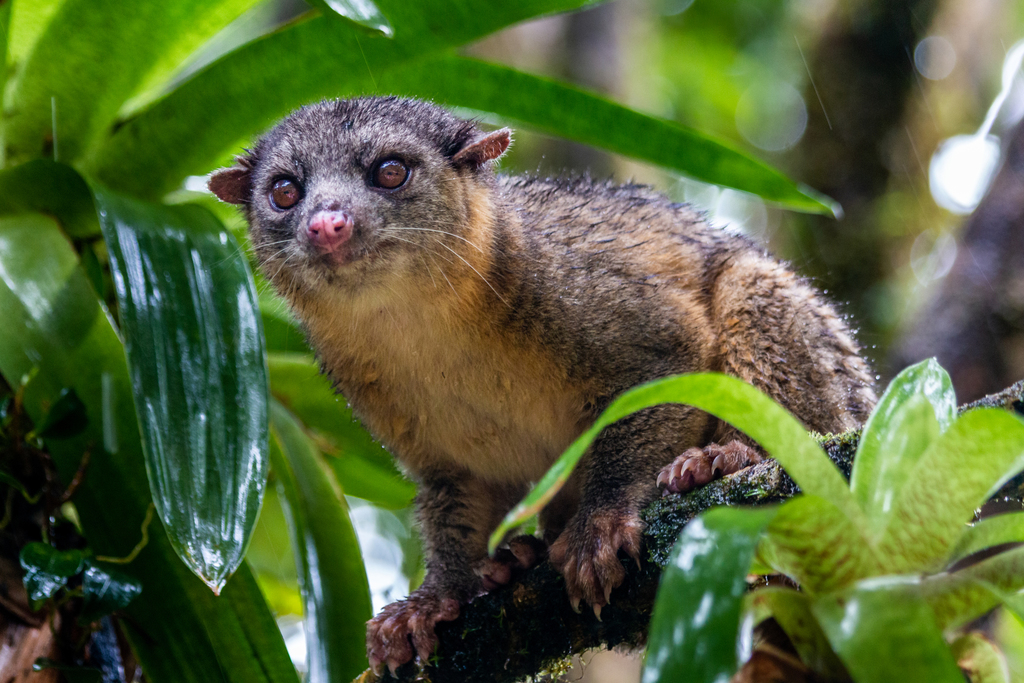
Tucked high in the rainforest canopies of Central and South America lives an elusive creature few people have ever seen: the Olingo. With its big eyes, bushy tail, and catlike agility, the olingo looks like something out of a storybook—but it’s a real, wild member of the raccoon family (Procyonidae), and one of the least understood.
Let’s take a closer look at this quiet jungle acrobat.
What is an Olingo?
The olingo (genus Bassaricyon) is a small, arboreal mammal related to raccoons, kinkajous, and coatis. There are several species, but all are tree-dwellers native to tropical forests in Central and northern South America.
Unlike its cousin the kinkajou, the olingo is leaner, more fox-like in shape, and lacks a prehensile tail. But don’t be fooled—it’s still an agile climber and master of life in the treetops.
Olingo Fast Facts:
- Size: About 14–17 inches long (plus a similar-length tail)
- Weight: 2–3 pounds
- Lifespan: ~10 years in the wild (up to 25 in captivity)
- Diet: Frugivore (mainly fruit), but will also eat insects and nectar
- Activity: Nocturnal and solitary
- Habitat: Tropical rainforests from Nicaragua to Ecuador
What Do Olingos Look Like?
Olingos have:
- Big, round eyes suited for night vision
- Soft, brownish fur and a long, bushy, ringed tail
- A slender body and narrow face
- Sharp claws for climbing
- No prehensile tail (unlike kinkajous), but excellent balance
They’re often mistaken for kinkajous at a glance, but olingos are more slender, lighter, and less vocal.
What Do Olingos Eat?
Olingos are primarily frugivores—fruit is the main item on the menu. They also supplement their diet with:
- Insects
- Nectar
- Occasionally small vertebrates
Their love of fruit makes them important seed dispersers in rainforest ecosystems.
Nocturnal and Nearly Invisible
Olingos are shy, solitary, and mostly silent, making them hard to study. They spend the day sleeping in tree hollows or dense foliage, coming out at night to forage. Their secretive habits mean they’ve remained under the radar, even in areas where other wildlife is well documented.
Relatives and Confusion
For a long time, olingos were grouped with kinkajous or misidentified. In fact, it wasn’t until 2013 that scientists formally described a new species of olingo—the Olinguito (Bassaricyon neblina)—after years of confusion in zoo records and museum specimens.
That discovery sparked new interest in olingos and their evolutionary history, though much remains unknown.
Conservation Concerns
Olingos are not currently listed as endangered, but they are vulnerable to:
- Deforestation and habitat loss
- Illegal wildlife trade
- Climate change
Because they depend on undisturbed tropical forests, olingos are often among the first to disappear when forests are cleared or fragmented.
Why the Olingo Matters
Despite its low profile, the olingo plays a crucial ecological role. As a seed disperser and insect predator, it helps maintain the balance of the rainforest. And as one of the raccoon family’s most mysterious members, it’s a reminder of how much we still have to learn about Earth’s biodiversity.
Final Thoughts
The olingo may not be famous, but it’s a quiet symbol of rainforest life—adaptable, elusive, and deeply intertwined with its habitat. In a world where wildlife often makes headlines for being in danger or conflict, the olingo is a whisper from the treetops: nature still has secrets worth protecting.
Want more profiles on rainforest animals or raccoon relatives? Check out our posts on the kinkajou, coati, and olinguito—the olingo’s adorable mountain cousin!
More photos below ↓








Disclaimer: This blog post is for edutainment purposes only and may not be entirely accurate.






